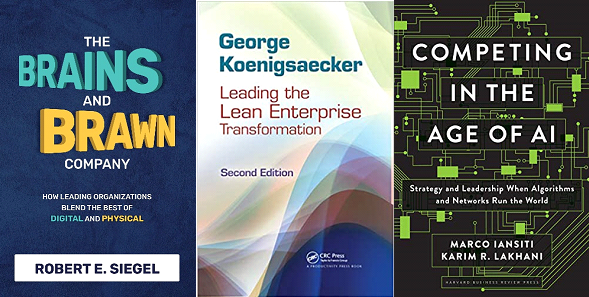“The first rule of any technology used in a business is that automation applied to an efficient operation will magnify the efficiency. The second is that automation applied to an inefficient operation will magnify the inefficiency” – Bill Gates (Capgemini, 2015).
Over the past decade, the way successful companies are managed has changed. The most critical of these changes pertain to how companies generate information, how it is shared across the company and how that shared information drives decision making. In particular, the role of the omniscient decision maker/capital allocator has diminished; now information & tech weaved together cleverly (rather than the ‘all knowing’ leader) runs the world’s great companies. Three books that the CEOs of our investee companies are reading illuminate this change.
- “Leading the Lean Enterprise Transformation” focuses on how manufacturing companies can use tech to crush costs in the supply chain and in the factory.
- “The Brains and Brawn Company” focuses on how conventional American companies like Charles Schwab, Target, and Kaiser Permanente (most of the case studies in the book are of services companies) are using tech and data to understand their customers’ demands better, personalise their services for them, and still be extremely competitive on costs.
- “Competing in the Age of AI” uses case studies of new age companies like Netflix and Peloton to help us understand how the ability to collect vast amount of customer data in real time allows companies to change the way they function on a day-to-day basis. Specifically, data – rather than the decisions of an all-knowing CEO – runs the company i.e., the traditional command-and-control style of going to market with annual planning & budgeting cycles is increasingly ineffective.
- How American companies have adapted successfully to the 21st century by using tech effectively. Central to their success has been having leaders who understand in-depth and in detail how tech and business processes interplay.
- The willingness of leaders to think deeply about how tech changes the dynamics of what can be offered to each customer (at what cost, at what level of variety/customisation, at what speed, etc) and how that changes the nature of competitive advantage in an industry.
- By itself tech is no panacea (because any company can now implement the SaaS versions of products like SAP and Salesforce) – it is the thoughtful and painstaking application of tech to extant business problems which allows firms like Danaher, Amazon, and Charles Schwab to leave their rivals behind.
“The Brains and Brawn Company: How Leading Organizations Blend the Best of Digital and Physical” by Robert Siegel
As more consumer internet IPOs head for the Indian stock market, we are being asked whether our investee firms are going to be disrupted by VC funded digital disruptors. At the other end of the world, Robert Siegel has authored an outstanding book on the same subject – the only difference is that he has reached a very different conclusion to what many investors in India have reached.
In ‘The Brains and Brawn Company: How Leading Organizations Blend the Best of Digital and Physical’, venture capitalist and Stanford Business School lecturer Robert Siegel shows that the majority of successful leaders from both incumbents and disruptors focus as much on things like logistics, manufacturing, and distribution as they do on digital innovation. In fact, Siegel demonstrates that many established companies are successfully countering young upstarts in other creative ways, and many new organizations are learning from their older brethren.
Siegel’s book shows how to create lasting profits and growth in the smartest way possible: by creating a solid partnership between digital innovation and traditional business operations i.e., “by marrying brains and brawn.”
The book is structured around several case studies including:
- Charles Schwab using cutting-edge analytics to better serve millions of investors without violating its original code of values.
- Align Technology transforming orthodontia by developing creative new business models along with new products.
- Kaiser Permanente tapping into the power of empathy to improve patient satisfaction while controlling costs.
- Instacart balancing ownership and partnerships to balance the needs of four key constituencies.
- Target, Best Buy, and Home Depot finding diverse ways to blend the best aspects of physical retail with innovative e-commerce.
- Desktop Metal innovating high-volume yet affordable production methods that can revolutionize manufacturing.
In a world where everything is connected, there’s bits and bytes moving, and leaders need to understand what happens when functions inside a company interact. What happens when your company is interacting with others inside of its ecosystem? There’s a flow to business and leaders need to be able to see that flow…You can’t stay in your lane anymore – you need to be good at multiple things and understand interactions.”
“Competing in the Age of AI” by Marco Iansiti & Karim Lakhani
This book by two Harvard Business School professors shows how reinventing the firm around data, analytics, and AI removes traditional constraints on scale, scope, and learning that have constrained business growth for hundreds of years. Just as importantly, the book says that if you and your firm aren’t taking advantage of these technologies, someone else will with obvious adverse implications for your firm.
For example, in just a decade, Airbnb has scaled to offer an inventory of >4.5mn rooms, 3 times what Marriott managed to in 100 years. All of this has been made possible by its AI ‘factory’ which aggregates data & uses complex algorithms to match dispersed users to disaggregated property owners.
Netflix is another interesting case study. It personalises the experience of each of its 150mn users. What you see on your screen is different from what your friend sees. Effectively, analytics has helped create 33mn different versions of Netflix! The case study doesn’t end there – Netflix’s investment decisions (in terms of what type of content it invests money in) is driven by the data generated by the viewing habits of millions of its customers rather than by the whims & fancies of its creative directors. Hence Netflix is driven by data rather than by an all-knowing, all-seeing CEO or creative director.
The authors have generalized the findings of research on 350 enterprises including the transformational journeys of Amazon, Microsoft & many others. They used these findings to provide a clear framework to help firms with navigating the fast-changing world of AI-led disruption. The authors have created an “AI Readiness Index” which, not surprisingly, shows how the most advanced enterprises enjoy superior growth & financial performance.
“Leading the Lean Enterprise Transformation” by George Koenigsaecker
At The Danaher Corporation, George Koenigsaecker led the lean transformations of both the automotive and tool groups. He also led The Hon Company’s successful lean conversion, which doubled productivity and tripled revenues, leading Industry Week to recognize HON on their list of the “World’s 100 Best Managed Firms.” In this book, Koenigsaecker presents successful strategies and case histories of several American executives who have been instrumental in executing “lean” (i.e., high quality production at the lowest cost possible) strategies.
Organized in the chronological sequence that a leader embarking on a lean journey would experience, this book operates both at the level of the factory manager and at the level of the Boardroom decision maker. It focuses both on the metrics that have to be tracked and the business processes that have to be followed for a company to operate at the level of excellence of Danaher (where Koenigsaecker worked through the 1980s and early 1990s and was the President of the firm’s largest business unit) or Toyota (a firm that Koenigsaecker has spent almost 50 years studying). [You can click here if you want a summary of the case studies and the metrics used in the book: https://www.slideshare.net/
The book excels in laying out in detail the business processes and the allied metrics which can be tracked (using technology) to ensure that the appropriate processes are executed as per plan. This includes:
- The True North metrics used by Toyota and how they drive every line item in the good direction
- The use of value stream analysis at the leadership level (value stream mapping is a tool that employs a flowchart documenting every step in the process).
- The use of successful kaizen events (i.e., the continuous improvement of business processes & practices) that improve the value stream
- Metrics which should be used for corporate assessment and business reviews in support of a lean transformation
Saurabh Mukherjea, Omkar Sawant, and Nandita Rajhansa are part of the Investments team at Marcellus Investment Managers (www.marcellus.in). Saurabh is the author of “Diamonds in the Dust: Consistent Compounding for Extraordinary Wealth Creation”.
Disclaimer
Marcellus Investment Managers is regulated by the Securities and Exchange Board of India as a provider of Portfolio Management Services and as an Investment Advisor.
The information provided on this website does not, and is not intended to, constitute investment advice; instead, all information, content, and materials available on this site are for general informational purposes only. Information on this website may not constitute the most up-to-date information. The enclosed material is neither investment research, nor investment advice. Marcellus does not seek payment for or business from this email in any shape or form. The contents and information in this document may include inaccuracies or typographical errors and all liability with respect to actions taken or not taken based on the contents of this site are hereby expressly disclaimed. The content on this website is provided "as is;" no representations are made that the content is error-free.
No reader, user, or browser of this site should act or refrain from acting on the basis of information on this [site/newsletter] without first seeking independent advice in that regard. Use of, and access to, this website or any of the links or resources contained within the site do not create an portfolio manager -client relationship between the reader, user, or browser and website authors, contributors and their respective employers. The views expressed at, or through, this site are those of the individual authors writing in their individual capacities only.





